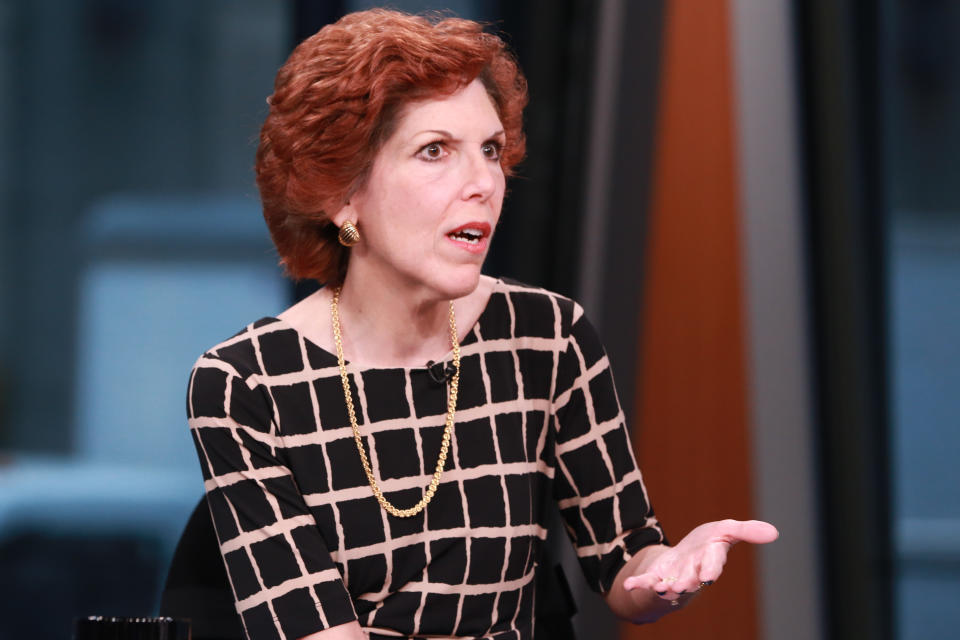Cleveland Fed's Mester: GDP to be about 6% lower than last year for 2020
Federal Reserve Bank of Cleveland President Loretta Mester says the U.S. economy will likely end 2020 at a level of GDP about 6% below where it was at the end of 2019.
“The unemployment rate will still be quite elevated, certainly not anywhere near February's level,” Mester told Yahoo Finance on the virtual sidelines of the Fed’s annual Jackson Hole conference. “And so we're just going to see how to really keep policy accommodative.”
Mester said the spread of the virus beginning in late June is “tempering” activity in the Cleveland Fed district, which covers Ohio and parts of Pennsylvania, Kentucky, and West Virginia.
The COVID-19 crisis has backed the Fed into near-zero interest rates and spurred policymakers to restart asset purchases and open liquidity facilities to backstop various financial markets.
Mester hinted that forward guidance, or more explicit clues on what the Fed may do in the future, “will be part of the toolkit that we use,” but said policymakers will continue to deliberate actually using such a tool in upcoming Federal Open Market Committee meetings.
“It’s going to depend on what the economy looks like going forward,” said Mester, who is a voting member of this year’s FOMC.
[Jackson Hole 2020: Cleveland Fed’s Loretta Mester speaks with Yahoo Finance - Transcript]

Inflation
On Thursday, Fed Chairman Jerome Powell announced that it had also officially changed its approach to inflation, now allowing for periods of time where inflation “moderately” runs above its 2% target.
The new framework hopes to nudge up inflation, where measures of core personal consumption expenditures (the Fed’s preferred measure of inflation) have run persistently below 2% since the Fed adopted that target.
Mester said the Fed will remain watchful of inflation running too high.
“The key thing is really wanting to anchor inflation expectations, so if we saw that we were allowing inflation to go up and it turned out to be that inflation expectations were being unanchored on the outside that would be a problem,” Mester said.
But more importantly, the Fed hopes that tolerating higher inflation will give policymakers more breathing room to allow accommodative monetary policy (i.e. near-zero interest rates) to pull more workers into the labor market.
The revised statement now says the Fed’s policy decisions need to be guided by assessments of “the shortfalls of employment from its maximum level.”
Powell said the change “reflects our view that a robust job market can be sustained without causing an outbreak of inflation.”
Mester said the economy still had a ways to go.
“It’s just a deep hole that we’re in and we’re making sure that we can get back to something that’s a more sustainable recovery,” Mester said.
Brian Cheung is a reporter covering the Fed, economics, and banking for Yahoo Finance. You can follow him on Twitter @bcheungz.
Jackson Hole: Fed Chair Powell unveils effort to target 'moderately' higher inflation
Jackson Hole Preview: Fed to take on 'deliberately vague' approach to targeting 2% inflation
KC Fed's George: US economy well-positioned 'to recover at some point'
World Bank's Malpass: China needs to 'fully participate' in debt relief
A glossary of the Federal Reserve's full arsenal of 'bazookas'
Read the latest financial and business news from Yahoo Finance
Follow Yahoo Finance on Twitter, Facebook, Instagram, Flipboard, SmartNews, LinkedIn, YouTube, and reddit.

 Yahoo News
Yahoo News 

